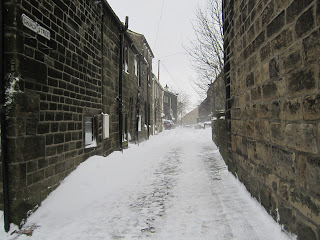Today we (Gail Crowther, David Fitzwilliam, and I) visited Heptonstall to see the gravesite of Sylvia Plath. It was during a snowstorm; the winds were vicious and snow was blowing and drifting everywhere; it had to be seen to be believed, which is why I took some video. The village of Heptonstall was quite and we were the first to traipse to the grave. After visiting the grave, we walked up through the village and into Heptonstall Slack to see the Beacon, where the house was exposed to the full force and fury of the storm. The road at the bottom of the images (and video) was impassable from the snow drifts. Retiring after this exertion for a coffee at the Cross Inn was well earned to warm up before facing the rest of the day.
This was my fourth visit to see Plath's grave and the first since 2003, which was in February of that year but at that time the weather was crisp and fine. Today's weather made for quite a surreal experience in what has been an truly magical, mysterious, and adventurous Plath-filled week with previous stops in London and in several Devon locations, which included seeing Plath book author's Andrew Wilson and Robin Peel, as well as a much loved meeting with Elizabeth Sigmund in which I got to chat-Plath and see
Plath's copy of the Collected Poems Dylan Thomas. I wanted to see Plath's grave especially in this year as it is the 50th anniversary of her death. The landscape of Yorkshire in 1963 might have looked similar to what I saw today as that was the year of
"The Big Freeze" when much of the country was under snow and ice.
Here are some pictures of the grave of Sylvia Plath, the Beacon, and Heptonstall. In addition to these images, I have also posted two videos on Sylvia Plath Info Blog's YouTube channel.








The grave looks pristine under the blanket of snow. I will be back there myself in just a couple of months. Hopefully it will be warmer then!
ReplyDeleteIt reads like a once-in-a-lifetime event so to be honest I'm glad that you three were there to not only witness but also record it here. Let me know next time you hit London.
ReplyDeleteYou'll remember the whiteness!!
ReplyDeleteGreat pics, video and blog post Peter. I can't believe you braved the Yorkshire cold!!!
ReplyDeleteLovely pics, Peter! Heptonstall looks beautiful covered in snow - particularly Towngate & Church Street. Yes, poignant reminder of the terrible winter of 1962-63...
ReplyDeleteEnjoy the rest of your trip!
~VC
Amazing pictures. Do you happen to know if there was snow on the ground at the time that SP was buried?
ReplyDelete